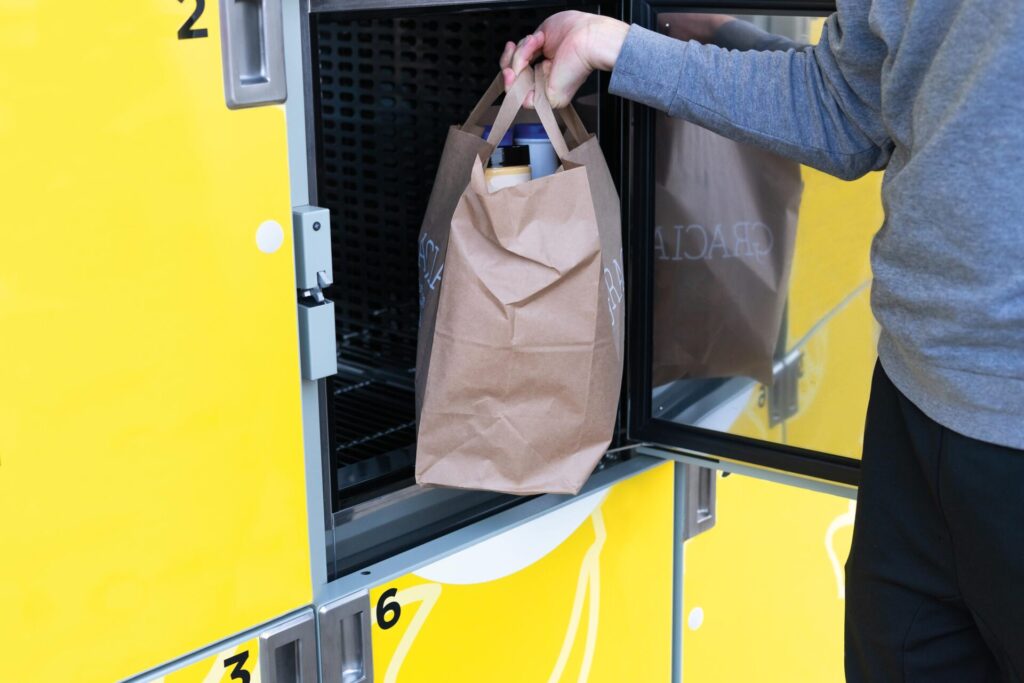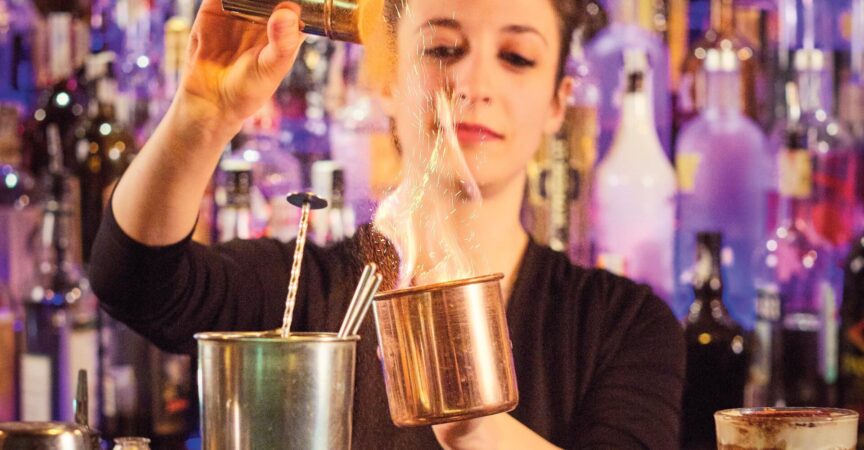The Future of Food & Beverage Through the Lens of Entertainment
Entertainment has always been at the heart of what consumers want when it comes to dining out. To meet these demands in today’s robust landscape, bars and restaurants need to up-level their offerings in the form of flavour and experience, leveraging tech trends and ensuring they are allies for betterment in the industry.
When we think about food and beverage pairings, we typically jump into flavour profiles like sweet and savoury as a key example, but consumers are looking for much more than traditions these days. The Heritage Lounge, a bar and restaurant in Australia, curated a list of 20 unique offerings including rum with peanut butter and sour lollies paired with a vodka cocktail—this is what intrigues consumers today. The more unusual or unique, the better, and a great example of this in Ontario is seen in the form of cider and chocolate pairings presented at Loch Mór Cider Company. Located in the sprawling countryside in Prince Edward County, patrons can experience local, award-winning craft cider paired with handmade, artisan, dark, single-origin chocolates. The whole experience is guided by a cider ambassador, so consumers aren’t just sipping and snacking, they’re learning as well.
Inherently, food and drink are something deeply rooted in our human emotions and dining out isn’t simply about sustenance. One brand that took this sentiment to another level was Philadelphia Cream Cheese by Kraft Heinz. They created a dining concept called “Feeladelphia” and partnered with award-winning chefs Jeremiah Stone and Fabián Von Hauske Valtierra to deliver a multi-sensorial and feelings-based dining concept and cookbook experience where consumers order feelings rather than food. It was a complete sensorial experience with sounds, visuals, and of course taste. This is an example of how brands can not only say they connect with their guests but truly build intimate experiences.
One insight on TrendHunter.com titled “Unlikely Pairing” explores the rich connection between beverages and experiences with alcohol brands offering unlikely pairings to go along with their beverages. Straying from traditional wine and cheese pairings, they offer unusual combinations that are likely to pique consumer interest. A whiskey and fragrance pairing curated in a partnership between the Scotch Malt Whiskey Society and fragrance house Kingdom Scotland is just one example of how brands are curating these new and memorable occasions.
Sixty-five per cent of consumers order from or visited a restaurant after seeing it on TikTok.
Bars and restaurants that want to connect more intimately with their customers need to step outside their own comfort zones. It also never hurts to create an experience your customers can—and want to—share on TikTok, Instagram and other social media platforms. In fact, Sixty-five per cent of consumers ordered from or visited a restaurant after seeing it on TikTok.
When we consider how technology continues to be a powerful force in our lives, our jobs, our hobbies, etc., it’s obvious that it plays a massive role in hospitality, too. In Canada, the top four most-used food apps include McDonald’s Canada, Uber Eats, DoorDash and Tim Hortons. One reason for this is because of the unparalleled reward system built into these apps. While traditional fast-food restaurants are increasingly having to compete with healthier QSR options, reward programs are helping to better engage customers and grow loyalty. This is also an increasingly desirable choice as prices continue to grow. The Sonic delivery service has made a commitment for everyone who orders through their app to automatically get half-priced drinks. As consumers increasingly turn to new and healthier fast-food options, brands in this space are having to adapt and offer more incentives to bring in new customers.
Another new introduction to this space is the QSR metaverse. Fast food chains are among the brands across a range of industries experimenting with products, services and marketing in the metaverse. Fast food restaurant brands are now creating virtual experiences and NFTs to stay up to date with Web3 innovations. Consumers’ growing interest in the metaverse comes from brands’ willingness to offer more engaging online experiences than they’re accustomed to. Quick-serve burger chain Wendy’s announced that it has expanded Wendyverse, its virtual reality platform located within Meta’s Horizon Worlds. The new expansion, called “Sunrise City”, will consist of a virtual breakfast realm where customers can explore a 3D breakfast-themed environment and participate in promotional “quests.” Specific elements of Sunrise City include a castle, flying biscuits and bridges built from bacon. In terms of activities, customers will be invited to partake in tightrope jousting, biscuit tossing and a unique, potato-themed paragliding game. The interactive nature of the metaverse and its potential in a wide range of industries means that brands’ options for designing and creating products or services in this space are limitless. The tricky part will be to balance brand objectives and stay true to that brand while honing consumer interest.
The last piece of technology that is becoming overwhelmingly popular is food lockers, and for good reason! Restaurants are using locker-like technology to offer contact-free food pickups, and this is available for everyone including fast food chains, restaurants and ghost kitchens. Due to the pandemic, consumers are now accustomed to contact-free purchasing. This is especially true in the food industry, which, in response to sudden lockdown measures, saw a deluge of new delivery and pick-up solutions pop up. And while these solutions made food ordering safer, they also made things more efficient and convenient for consumers. In fact, by 2027, the smart parcel locker market size in North America is expected to exceed $450 million USD.
From upgraded loyalty apps to metaverse expansions and even smart food lockers, the amount of technology available to bars and restaurants today is boundless, but brands don’t need all of it. It’s about using what fits the brand and meets your consumer’s needs.
From upgraded loyalty apps to metaverse expansions and even smart food lockers, the amount of technology available to bars and restaurants today is boundless, but brands don’t need all of it. It’s about using what fits the brand and meets your consumer’s needs.
By 2027, the smart parcel locker market size in North America is expected to exceed $450 million USD.
One additional need consumers are seeking from the hospitality industry is community. “Shopping local” continues to win, which means “dining local” will also see benefits, but consumers want to dine where they are welcome. The ‘Unified Bar’ insight on TrendHunter.com looks at how bars and restaurants are taking initiatives to bring communities together and support those in need. Using their platforms as community establishments for social outreach, the companies are creating more inclusive environments through in-house initiatives and branded donations for worthy causes. One Toronto-based event from September 2022 is Home Grown: A Talk and Taste with Beer Diversity’s Ren Navarro. This event discussed the fact that, over the next 30 years, Northcrest Developments will be transforming the 370-acre Downsview Airport Lands into a series of vibrant new communities. Guests were invited to taste a delicious Downsview pilsner, specially commissioned by Northcrest and produced by Red Tape Brewery. Attendees were also encouraged to bring curiosity and questions to Navarro’s exclusive beer talk about the creation of the beer itself and her quest to increase diversity in the Canadian beer industry. The event was limited, but offered free of charge to those who could attend, which is an amazing way to reach your community and educate them in a meaningful and fun way. This resonates because, throughout the pandemic, North Americans who were given the opportunity to work safely from home have had more time for introspection, leading to a greater appreciation of community and social interactions. As consumers continue to look inward and reassess their values, they expect companies to do the same. In response to this social change, businesses are increasing their community involvement to create a more inclusive environment for customers.

One final method for maintaining a positive and loving community is the hybrid model. A trend that emerged many years ago, the hybrid model was about creating many spaces in one and, in this post-lockdown era, this is what consumers are looking for. Restaurant-store hybrids merge the dining and retail industries bridging the gap between shopping and eating. While it’s not uncommon for retail stores to contain restaurants, the reverse—dining establishments that also operate as stores —are becoming more popular. These intimate spaces create more modern versions of the one-stop experiences that large retailers have made so popular. They can easily be compared to the brewery and bottle shops we’re seeing in the beverage industry. In Toronto, the Society of Beer Drinking Ladies Clubhouse is a perfect example of a hybrid space that includes a taproom, bottle shop, coffee bar, artisan market and event space all in one!
People shop and engage with brands differently than they did 10 or even five years ago and, with the growing popularity of eCommerce, consumers now need more persuasion to be drawn to in-person shopping and dining experiences. Factors like the convenience and enhanced experience—often associated with online shopping—now need to be replicated in brick-and-mortar spaces to motivate consumers to show up in person. The good news for bars and restaurants is that four out of five of today’s consumers feel closer to their communities than they did at the beginning of the pandemic, and you can bet hospitality is a huge reason for this.
When we think about the future of bars and restaurants, we think about how entertainment can play a huge role in innovation. Beyond basic definitions of entertainment, consumers are looking for uniqueness, technology that speaks to them, and places they can feel at home.









